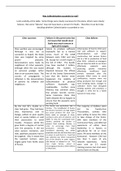Was Collectivisation successful or not?
Look carefully at the table. Some things were clearly successes for the plans; others were clearly
failures. But some “failures” may not have been a concern for Stalin. Therefore it can be tricky
deciding whether Collectivisation succeeded or not.
Clear successes Failures in the purest sense but Clear failures
not issues that would cause
Stalin very much concern in
light of his targets.
Class warfare was encouraged. Failure to produce sufficient Initial quotas of food to 1931 were
Although it was not as foodstuffs led to a famine met and sufficient to support
successful as hoped, the Kulak across much of the USSR industrialisation and urban
class was targeted by some between early 1932 and late construction, but various factors
led to a fall in production of food
poorer peasants. 34, except for a brief respite in
after 1931. Activists as managers
Denunciations were made by the fall of 1932. The deaths did not have the skills to run farms
neighbours of richer peasants, may have reached 7 million, effectively; peasants were
although often this was based although this number is practising passive resistance
on personal grudges rather disputed because the official effectively; insufficient draft
than on an economic basis. The line of the Soviet Government animals remained after the
success of propaganda is was that the famine never peasants killed many to avoid
reflected in the denunciations happened; the inability of confiscation; tractors were not
of parents by children and collectivisation to produce being produced fast enough and
neighbours. sufficient foodstuffs was were breaking down; changes to
collective farms had disrupted
inadmissible. Further, since
existing systems and practices; a
illiteracy was common place, drought in 1931 led to a failed
few private records survive. harvest in many areas.
Some historians think that
Stalin allowed this to happen to
ensure that the peasants were
working hard.
By the mid 30’s, Kulaks as a The famine was particularly bad in The majority of Kolkhoz were
class had gone. They had been Ukraine. The breadbasket of Russia, led by Twenty‐Five
the Ukraine had been set high targets
shot, imprisoned, sent to but actual produce fell each year. Thousanders, activists who
Gulags, settled on poor quality Stalin made an example of them, were willing to leave the cities
land, or purely hidden or sold sending in extra units of collectors and to take charge of the farms.
their possessions to avoid OGPU to strip the countryside bare. 69% were members of the
Soldiers patrolled the borders to
trouble. However, whilst this Communist Party, and 48% had
prevent food entering Ukraine, in
gave Stalin a degree of control order to encourage more food experience of either team
over the peasants, it did not production internally. Stalin leadership in a factory or
solve passive resistance, and considered deporting the whole agricultural for 12 or more
new, apathetic peasants had to population but was told that there was years. 9% were members of the
no where to send them to. Food that
be targeted. Also it meant that was collected was either transported Komsomol. However 13% had
the talented farmers were out of the Ukraine to other regions, less than 5 years of any
largely gone from fertile areas sold abroad, or allowed to rot. This relevant experience. Some
of Russia. man made famine, aimed at were sent on 2‐3 month
encouraging production, killed millions
of Ukrainians.
training courses, but most were
sent to learn on the job.





